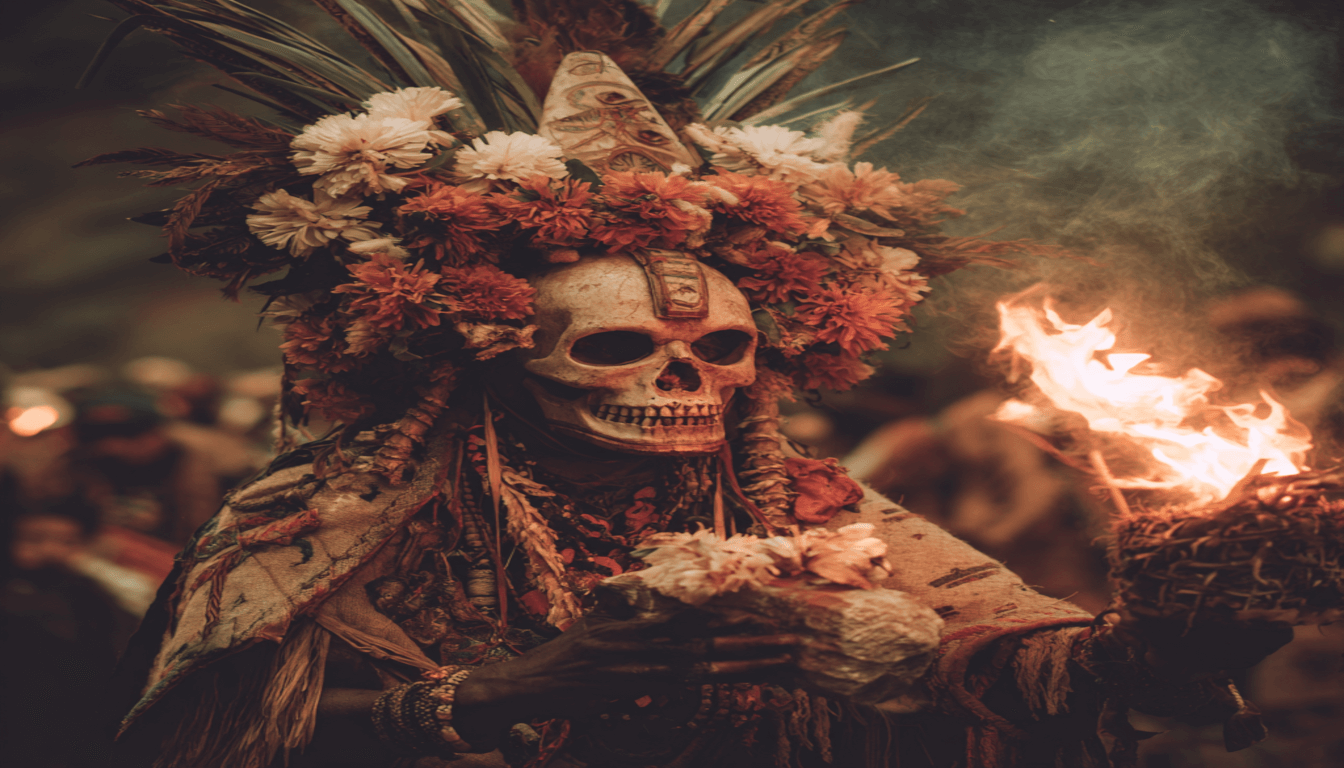Can the beat of a drum open a doorway between the living and the spirit world? In New Orleans and across the Atlantic world, communal rites moved people into states of connection, care, and balance.
This Ultimate Guide clarifies the religion’s history and living traditions in New Orleans while placing practices in a wider Atlantic context. It explains how ceremonies, offerings, and healing rites functioned as integrated acts that bound communities to spirits and ancestors.
Readers can follow deeper process and meaning in Understanding Voodoo Rituals: Purpose, Process, and Spiritual and explore mechanisms of spiritual care in How Voodoo Heals: The Spiritual and Physical Aspects of Voodoo. Core elements previewed here include vevès, drapos, the poto mitan, call-and-response, drumming, and possession.
Practices grew from West and Central African roots, Catholic imagery, and local culture. Figures such as Marie Laveau and neighborhood temples anchored life, while ethical foundations—respect, reciprocity, and balance—counter sensational myths.
Key Takeaways
- Rituals linked community, spirit relations, and everyday life.
- Ceremonial phases include preparation, invocation, possession, and farewell.
- Symbols and offerings act as living expressions of honor, not props.
- Marie Laveau and community temples shaped New Orleans practice.
- Ethics of respect, reciprocity, and balance are central.
Understanding The Roots: Haitian Vodou And Louisiana Voodoo In Context
This section traces how West and Central African beliefs crossed the Atlantic and took new shape in port cities.
Lineage began with Fon, Ewe, and Yoruba peoples whose cosmologies survived the Middle Passage. Enslaved communities adapted those systems under new social constraints. Over time, practices blended with Catholic observance and local customs to meet changing needs.
West And Central African Lineage And The Middle Passage
Religious knowledge traveled with people and memory. Key figures in the pantheon—Legba, Erzulie, Damballa, and Baron Samedi—kept African roles as intermediaries between humans and the divine.
Syncretism With Catholic Saints And Local Traditions
Syncretism offered a public face: saints provided familiar markers for honoring spiritual intermediaries. Visual symbols and specific items like candles, vevès, and drapos encoded meaning and guided communal practice.
From Haiti To New Orleans: Cultural Exchange And Adaptation
Migration and trade moved beliefs from the Caribbean to New Orleans neighborhoods and parishes. The city blended African vodun with Catholic rites, Native American elements, and European folklore to form a distinct cultural fabric.
“Practices varied by temple and leader, reflecting local influences and evolving community needs.”
| Feature | Haitian Vodou | New Orleans Form |
|---|---|---|
| Primary influences | Fon, Yoruba, Kongo | West African, Catholic, Native American |
| Public practice | Community temples, feast days | Neighborhood temples, public processions |
| Symbols and items | Vevès, altars, libations | Drapos, candles, hybrid iconography |
| Role of saints | Direct syncretism with saints | Saint imagery used alongside local figures |
These roots shaped enduring traditions that bound community memory and identity. Readers who want ceremony mechanics can continue with Understanding Voodoo Rituals: Purpose, Process, and Spiritual.
Core Beliefs And Spirits: Bondye, Loa, And The Spirit World
At the heart of belief lies a remote creator and a living network of intermediaries who shape daily practice.
Bon Dieu is seen as a distant creator. Devotees rely on the loa as intermediaries who handle everyday needs, direction, and protection. This theological structure makes the spirit world active and accessible through practice.
Papa Legba, Erzulie, Damballa, and Baron Samedi
Papa Legba opens gates and sets the path for voice and movement. Erzulie represents love, beauty, and compassion. Damballa appears as the serpent of life, linked to creation and continuity. Baron Samedi governs boundaries between life and death and calls attention to transformation.
Intermediaries, Presence, And Reciprocity
Possession is treated as a sacred sign of presence. When a spirit takes someone’s body, messages pass to the community. Protocols, songs, and care protect participants and validate outcomes.
- Reciprocity: songs, service, and gifts sustain ongoing connection.
- Harmony: ethical behavior and regular practice keep life balanced.
- Practice over doctrine: altars, chants, and communal validation matter most.
For deeper context on ancestral ties and mutual obligation, see Ancestral worship.
| Role | Domain | Community function |
|---|---|---|
| Papa Legba | Gatekeeper, speech | Opens access, begins rites |
| Erzulie | Love, compassion | Guides relationships, counsel |
| Damballa | Creation, life | Symbolizes continuity, fertility |
| Baron Samedi | Death, transformation | Manages boundaries, final rites |

Ritual Spaces And Symbols: Altars, Vevès, And The Poto Mitan
Sacred spaces are arranged to hold presence, to mark where the seen meets the unseen.
The poto mitan serves as an axis that links the visible world and the spirit realm. In New Orleans practice, circles of movement and song form around this central post. It organizes focus and guides processionary steps.
Drawing Sacred Geometry To Invite Spirits
Vevès are precise designs traced in powder or chalk. They act as sacred geometry that calls specific loa and creates a protective boundary. Dancers often trace the vevè’s lines with their steps, so movement and symbol work together.
Altars, Drapos, Candles, And Libations
Altars hold candles, libations, stones, bones, and meaningful objects. These elements anchor intention and prayer. Where readers want item-level guidance, consult Common Voodoo Offerings: Meanings Behind the Rituals for details.
Symbolism Of Snakes And Transformation
Snakes symbolize Damballa and themes of renewal and cyclical change. Some communities historically included animal sacrifice as a sacred exchange; practice varies and often involves communal sharing.
- Drapos encode color and emblem to direct attention.
- Cleanliness and careful prep are key elements of respect and efficacy.
- Observe local temple norms to align objects and symbols properly.
Voodoo Rituals Healing Offerings Ceremonies Haitian Louisiana Vodou
This guide serves both newcomers and experienced practitioners who seek clear, respectful direction on practice and culture.
Who this section helps: It targets readers curious about local practice and those refining responsible methods. It outlines selection of offerings, altar etiquette, and customary timing within New Orleans culture.
Readers will learn how to choose items with intent, set a clean altar, and time acts to match weekly and seasonal rhythms common in households and temples.
For step-by-step process guidance, consult the sacred process walk-through and refer to vevè and symbol resources for design context. For item meanings, see Common Voodoo Offerings: Meanings Behind the Rituals.
Practical points for respectful practice
- Observe local leaders and confirm protocols before participating in public gatherings.
- Use clear terminology and avoid stereotypes when discussing the tradition.
- Choose simple home rites first; join temple events only after invitation.
- Follow ethical norms: consent, reciprocity, and community guidance.
| Aspect | Home Practice | Temple / Public Practice |
|---|---|---|
| Scale | Small altars, daily attention | Group rites, scheduled feasts |
| Timing | Weekly offerings, personal anniversaries | Seasonal festivals, communal calendar |
| Authority | Householder or family elder | Priest, priestess, or temple council |
| Etiquette | Private preparation, respectful gifts | Formal songs, guest protocols |
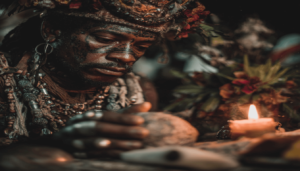
Verify sources: Learn from established leaders in New Orleans, read primary accounts, and cross-check with community publications. The guide includes checklists and references to support accurate, respectful practice.
Invocation, Possession, And Ceremony: How Spirits Are Welcomed
Song and drum begin in measured steps to invite spirit attention and shape group energy.
Invocation follows a clear sequence: opening songs, a call to Papa Legba, then a steady rise in tempo so the presence can enter. Drumming, rattles, and call-and-response singing use African-derived languages and local phrases to align intent with specific spirits.
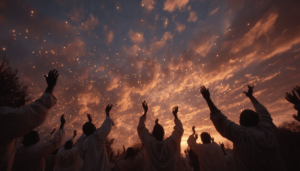
Call-And-Response, Drumming, And Chants
Leaders start with simple refrains and set drum patterns that match a loa’s character. Rhythm families guide the beat and anchor movement. Practitioners and drummers watch tempo closely to keep energy steady.
The Sacred Moment Of Riding And Messages For The Community
Possession — often called “riding” — is treated with care and respect. A person who becomes a vessel is supported by attendants who ensure safety and record messages for communal use.
Community protocols include holding space, listening without spectacle, and documenting guidance for future counsel.
Deep Dive: The Role of Dance and Music in Voodoo Ceremonies
Dance links movement to sound. Steps follow the drum’s phrasing and help sustain trance states. Specific dances cue which spirit may arrive and how it will communicate.
Closing rites ground participants. Songs slow, drumming softens, and leaders offer thanks to departing spirits. Timing respects neighborhood norms, especially in New Orleans, and trained leaders safeguard participants throughout.
| Phase | Key Action | Responsibility |
|---|---|---|
| Opening | Calls to gatekeeper spirits, slow chant | Lead singer, priest/priestess |
| Intensification | Rhythm rise, call-and-response | Drummers, chorus |
| Possession | Support, message transmission | Attendants, recorders |
| Closing | Grounding songs, thanks | Leaders, drummers |
For techniques on rhythm families and etiquette during trance states, see The Role of Dance and Music in Voodoo Ceremonies. Practitioners should study under experienced leaders to learn safe, disciplined methods that honor the tradition and community.
Healing And Protection: Herbal Wisdom, Spiritual Baths, And Gri-Gri
Local plant lore and protective crafts formed a core of community care in New Orleans and nearby parishes. Botanicas supplied dried plants, oils, and candles that practitioners used to prepare baths, charms, and poultices.
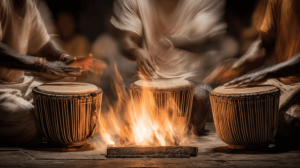
Botanicals, Spiritual Baths, And Cleansing Rites
Spiritual baths combined prepared herbs, holy water, and spoken prayer to cleanse and restore personal harmony. Preparation, prayer, bathing, and careful disposal of used botanicals are standard steps.
Protection Walls, Powders, And Home Boundaries
Household protections include salt lines, red brick dust at thresholds, and doorway blessings that mark clear boundaries. Powders such as salt or ash create a simple, tangible shield around a home.
Gri-Gri Construction And Purpose
Gri-gri are amulets built from roots, stones, and small sacred objects. Selection is targeted to specific needs: health, travel, or long-term protection. Practitioners wrap and consecrate each charm with intention.
Care, Distinctions, And Further Reading
Communal temple rites differ from individual rootwork aimed at countering curses; the latter is often associated with separate Hoodoo traditions. Practitioners diagnose imbalance and recommend items and steps with consent and clear ethics.
For plant profiles and bath formulas, consult Herbal Remedies in Voodoo Healing. To link spiritual intent with physical care, see How Voodoo Heals: The Spiritual and Physical Aspects of Voodoo Healing.
Offerings And Their Meanings: Food, Drink, Coins, And Flowers
Small plates, coins, and blossoms function as language on an altar, communicating intent more than words.
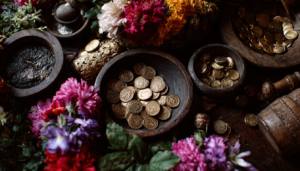
Purpose: Gifts serve as reciprocal gestures that build trust and honor spirits in both household and temple settings. They act as visible pledges and practical means to request guidance or protection.
Principles for choosing items center on color, scent, and flavor. Red favors passionate or protective requests; white suits clarity and peace. Sweet foods and rum often suit gentle, benevolent spirits.
Aligning Items With Specific Loa
Vevès, candles, and selected objects act as signatures to invite a particular spirit. Match textures and symbols to a loa’s character so petitions feel coherent and respectful.
Setup Etiquette And Care
Keep altars clean, orderly, and refreshed on a set schedule common in New Orleans practice. Place food and drink neatly, light candles safely, and pour libations as living prayers.
Coins express gratitude and ongoing commitment. Protective offerings—salt lines, herbs, or consecrated powders—should be disposed of respectfully, often by burial or dedicated removal, and refreshed regularly.
Practice notes: Keep a simple ledger of what was offered and the outcome. In complex petitions or public rites, involve experienced practitioners to ensure protocol and local regulations for open flames and public space are followed.
For a detailed matrix of pairings and meanings consult Common Voodoo Offerings: Meanings Behind the Rituals.
Ancestors And Community: Honoring The Living And The Dead
Families in New orleans often kept a quiet altar of photos and mementos to sustain ties across generations. Such household shrines placed framed images, a favorite cup, and modest tokens that matched family customs.
Altars, Photos, And Sacred Days
Altars served as daily reminders. People set photos, heirlooms, and simple offerings on feast days tied to All Saints’ and All Souls’ observances. These dates folded Catholic calendars into local practices and shaped seasonal attention.
Communal Rites, Guidance, And Protection
Neighborhood memorials gathered neighbors for public remembrance and reconciliation. Group rites sought guidance, protection, and the repair of social bonds.
- Build an ancestor altar with photos, small keepsakes, and items meaningful to the family.
- Observe timing that mirrors parish and neighborhood calendars for shared presence.
- Follow etiquette for grave visits: ask permission, handle remains respectfully, and use careful language.
Ancestor veneration strengthened family identity and daily obligations. It often preceded petitions to other spirits, establishing right relationship before further requests.
“Honoring the dead kept living lines balanced and accountable.”
For structured prayers and seasonal formats, consult Ancestral Worship in Voodoo. Practitioners should take safeguards when working with sensitive histories and grieving people, and coordinate household remembrance with temple practice to protect both privacy and tradition.
New Orleans Voodoo In Practice: History, Figures, And Cultural Life
Across the Crescent City, historic figures and modern temples shape how practice appears in streets and shrines.
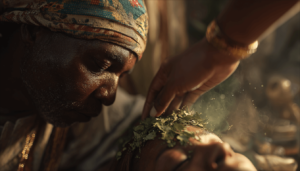
Marie Laveau And Her Legacy
Marie Laveau led public rites, counsel, and community care in the 19th century. Her blend of Catholic form and local custom made her a central figure in city life.
She remains a touchstone for people studying history, community leadership, and the social roles once held by trusted elders.
Temples, Shops, And Public Touchpoints
Today’s landscape includes museums, Rev. Zombie’s House of Voodoo, Marie Laveau’s House of Voodoo, and the Voodoo Spiritual Temple.
Visitors learn in shops and temples, then move from observation to participation under community guidance. See local resources at New Orleans traditions.
Festivals And Modern Expression
Public events—like the Voodoo Music + Arts Experience and St. John’s Eve—mix music, processions, and public offerings. Songs and drum patterns reflect haitian vodou influences in language and rhythm.
Possession in public settings now emphasizes consent, safety, and trained attendants. Second-lines, jazz, and neighborhood observances keep practice active in everyday culture.
| Site | Role | What to See |
|---|---|---|
| Voodoo Spiritual Temple | Teaching & public rites | Altars, talks, guided visits |
| Marie Laveau’s House | Historic landmark | Exhibits, curated drapos and vevès |
| Voodoo Music + Arts | Festival | Music, processions, public displays |
Ethics, Misconceptions, And The Line Between Voodoo And Hoodoo
Respectful practice starts by correcting myths that sensationalize a living faith. Media often depicts sinister scenes, but the core is reciprocity, humility, and service to community.
Balance, respect, and reciprocity over sensationalism
People who follow this religion prioritize care for neighbors and shared obligation. Leaders teach consent, safety, and accountability as central duties. For an ethics-first treatment, see How Voodoo Heals for guidance on care and reciprocity.
Community ceremony versus individual rootwork
Communal rites focus on relationships with spirits and community welfare. By contrast, Hoodoo is often private rootwork aimed at personal ends. For a clear comparison, review the differences between Hoodoo and Voodoo.
- Protection typically begins with cleansings, boundaries, and group support before any retributive step.
- Traditions evolve under elders’ oversight and collective stewardship.
- Use language that avoids stereotypes and honors local leadership.
Practical note: Learn from reputable temples and elders. Responsible practice includes ongoing self-examination, consent, and respect for sacred items and spaces.
Music, Dance, And Art: The Cultural Pulse Of Ritual Life
Music and movement act as a shared language that both summons spirits and shapes communal memory.
Drum cycles, call-and-response, and stepping patterns function as core elements of invocation. Drumming sets tempo while singers cue phrases. Dancers translate those cues into movement, and that motion guides energy through the group.
Rhythm As Invocation And Healing
Trained practitioners coordinate song lists and tempo to match a spirit’s character. Call-and-response keeps the group aligned. Coordinated breathing, steady steps, and rhythm can ease tension and support communal healing.
From Ritual To Jazz, Blues, And Second-Line
Local music styles grew from these patterns. Jazz, blues, zydeco, and second-line parades carry rhythmic logics and visual symbols into public life. Artists use flags, beadwork, and paintings to teach and inspire during public performances.
Safe practice matters: attendants monitor intense moments and manage possession with care. Others should observe, learn, and seek permission before joining. For rhythm families and technique, consult The Role of Dance and Music in Voodoo Ceremonies. For mechanisms of rhythmic recovery see How Voodoo Heals.
Conclusion
The final note reminds readers that the tradition is a living faith grounded in service, not spectacle.
In New Orleans this religion centers on relationships, practiced with clear protocols and shared beliefs. Study and practice aim to sustain community, respect ancestors, and hold spirit ties with care.
Next steps: consult Understanding Voodoo Rituals for process and ethics, Common Voodoo Offerings for practical guidance, Herbal Remedies in Voodoo Healing for plant work, and Ancestral Worship in Voodoo to root practice in lineage.
Begin with small ancestor work and balanced offerings that reflect love, harmony, and balance in daily life. Seek mentors, document progress, and always act with honor and community consent. Healing is iterative; respectful participation keeps the world of practice safe and meaningful.
